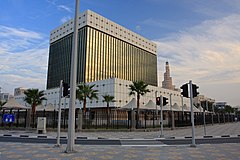Qatar Central Bank
| Headquarters | Doha |
| founding | 1973 (as Qatar Monetary Agency ) |
| president | Abdullah Saoud al-Thani |
| country | Qatar |
| currency | |
| ISO 4217 | QAR |
| Currency reserves | $ 37.475 billion (June 2020) |
| Website | |
| List of central banks | |
The Qatar Central Bank ( Arabic مصرف قطر المركزي) is the central bank of Qatar based in Doha .
history
Prior to 1966, the one-to-one Indian rupee- pegged Gulf rupee was legal tender in Qatar. When India devalued the rupee (including the Gulf rupee) by about 35 percent, Qatar and Dubai decided to replace the Gulf rupee with the Saudi riyal as a temporary measure pending the issuance of a new currency . On March 21, 1966, Qatar and Dubai signed a currency agreement creating the Qatar Dubai Currency Board . On September 18, 1966, the new board of directors issued the first national currency - the Qatar-Dubai riyal - with a face value of 0.186621 grams of pure gold .
The Qatar Dubai Currency Board was dissolved after Dubai became part of the United Arab Emirates in December 1971 . On May 13, 1973, the Qatar Monetary Agency (QMA) was established by law to act as a central bank. In 1973, the Qatar-Dubai riyal was replaced by the Qatar riyal.
The Qatar Central Bank (QCB) was founded in August 1993 as the successor to the QMA. The QCB stuck to the policy of a fixed exchange rate against the US dollar . The fixed rate of 3.64 QAR per USD has been anchored in law since July 2001.
aims
The Law of the Central Bank of Qatar and the Regulation on Financial Institutions, enacted by virtue of Law No. 13 of 2012, define the objectives of the Qatar Central Bank and its relationships with other institutions in Qatar in accordance with Part II of Articles 5, 6, 7 and 8 as follows:
Article 5 states that, within the framework of Qatar’s general economic policy, for the purpose of developing and supporting the national economy, the QCB shall:
- Monetary preserve and monetary stability guarantee;
- To act as a supervisory, controlling and monitoring body for all service, business, market and financial activities within or through the State of Qatar in accordance with international standards and practices;
- Creating a stable, transparent, competitive and responsible sector to conduct services, business, markets and financial activities based on market rules;
- Building public confidence in Qatar as a landmark global hub for services, businesses, markets and financial activities;
- Ensure the steady development of these sectors in line with Qatar's economic and overall development goals.
Article 6 describes how to achieve the objectives of general economic and development policy in cooperation and coordination with the relevant ministries and government agencies in a way that does not conflict with the following objectives:
- The stability of the Qatari riyal and its ability to be exchanged for other currencies;
- Stability of prices for goods and services;
- Financial and banking stability.
Article 7 defines that the Qatar Central Bank, as the competent higher authority, interprets and enforces state monetary policy, exchange rate policy and financial and banking supervision within the framework of the national strategy and in accordance with international standards and carries out the necessary measures. This includes u. a. the regulation of the currency in circulation and the management of currency reserves .
Finally, Article 8 defines u. a. the role of Qatar Central Bank in relation to business and financial activities conducted by or through the Qatar Financial Center (QFC) and the enforcement of policies related to the regulation, control and supervision of all financial markets in Qatar.
organization
The board of directors of Qatar Central Bank consists of seven members. The chairman of the board is (since 2006) Abdullah Saoud al-Thani , his deputy is Fahad Faisal al-Thani . Other members are Saleh M. al-Nabit, Ibrahim al-Ibrahim and Nasser Ahmed al-Shaibi. As a representative of the Qatari Ministry of Finance, Khalaf Ahmad Almanai is a member of the committee. Rashid al-Khater represents the Ministry of Economy and Commerce.
Connections to international terrorism
The Qatari citizen Khalifa Muhammad Turki al-Subaiy - a former employee of the Qatar Central Bank - has been on the official blacklists of the USA and the UN as a terrorist financer since 2008 . He should u. a. the 9/11 -Chefplaner Khalid Sheikh Mohammed supported financially and with other high-ranking al-Qaida have worked intermediaries. Al-Subaiy was ultimately convicted in absentia in 2008 by a court in Bahrain for "financing terrorism, training in terrorism, facilitating travel abroad for terrorist training and membership in a terrorist organization". Two months later, in March 2008, he was arrested in Qatar and imprisoned for these offenses. Al-Subaiy was released in September 2008 after only six months.
Web links
- Official website of the Qatar Central Bank (QCB)
Individual evidence
- ↑ Qatar foreign exchange reserves. In: CEICData.com. Retrieved August 27, 2020 .
- ^ History. Qatar Central Bank, accessed November 30, 2017 .
- ↑ Royal Decree no.34 of 2001 , signed by Emir Hamad bin Chalifa Al Thani on July 9, 2001.
- ↑ Core purposes: QCB objectives. Qatar Central Bank, accessed November 30, 2017 .
- ^ Board of Directors. Qatar Central Bank, accessed November 30, 2017 .
- ↑ QDi.253. United Nations and the Security Council Affairs Division (DPA), October 10, 2008, accessed November 30, 2017 .
- ^ Robert Mendick: Bankers who financed 9/11 mastermind now funding terrorists in Syria and Iraq. In: Telegraph.co.uk. October 4, 2014, accessed November 30, 2017 .
- ↑ Nasser El Massry (pseudonym): Islamism and the West: Good Terrorists - Bad Terrorists . 2nd Edition. BoD, 2015, ISBN 978-3-7412-5659-2 , pp. 112–113 ( limited preview in Google Book search).
